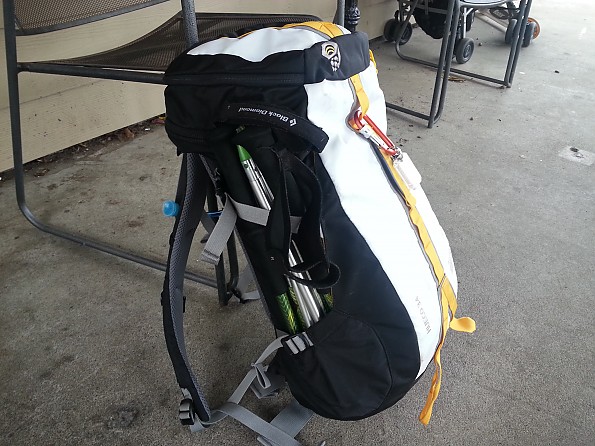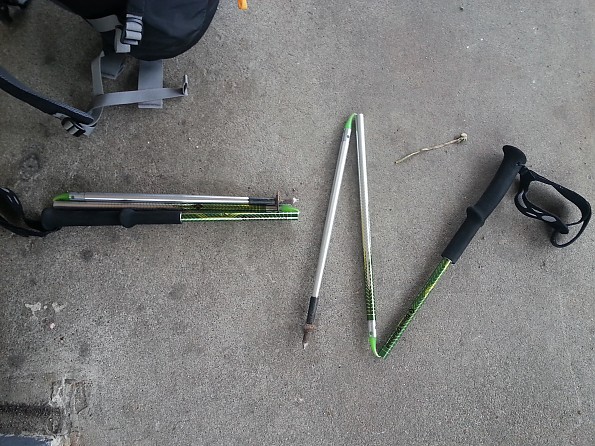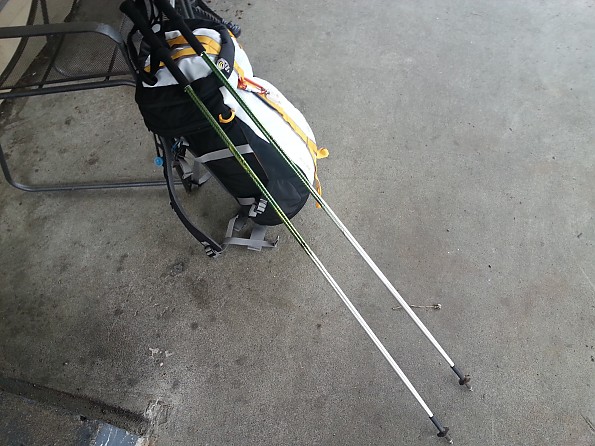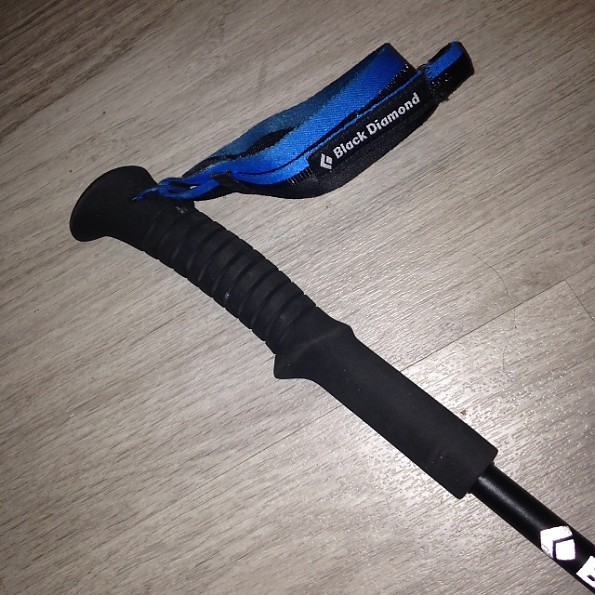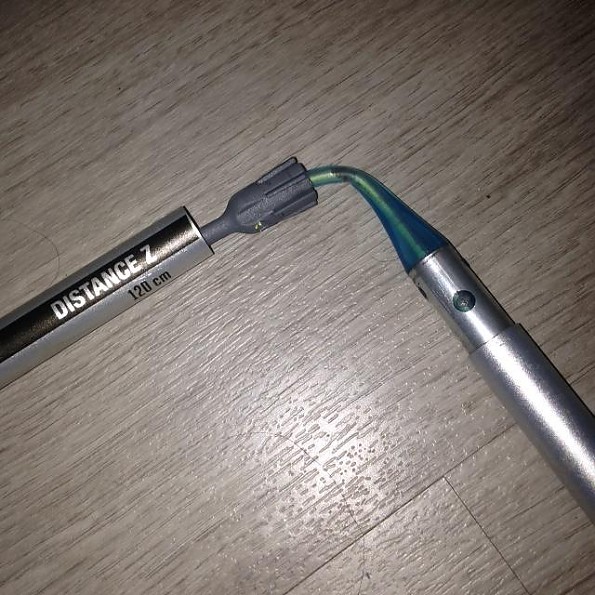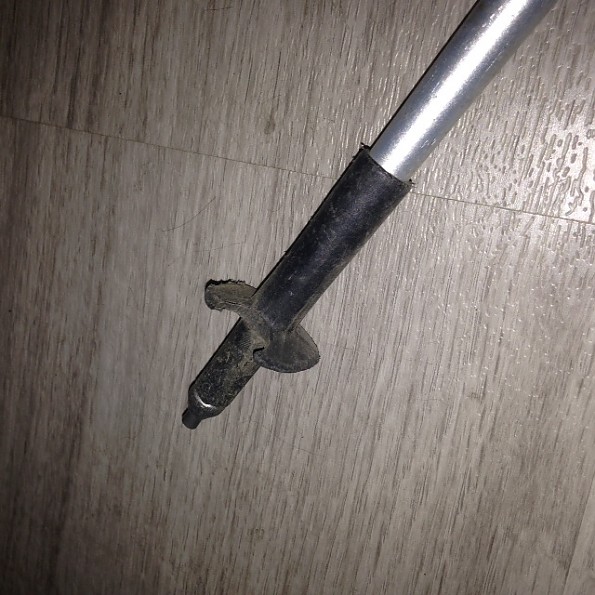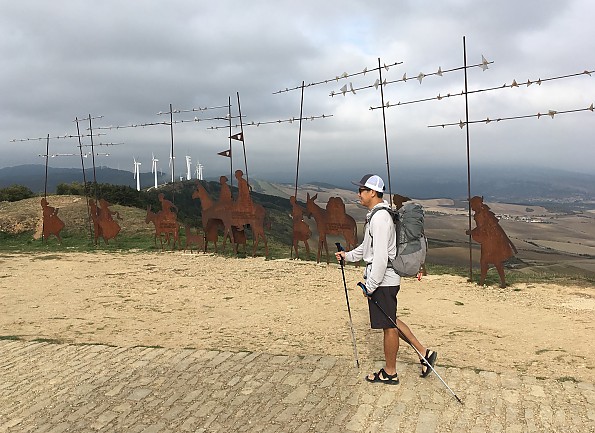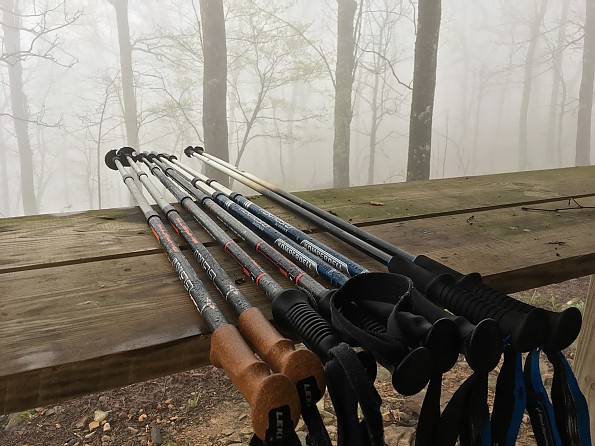Black Diamond Distance Z
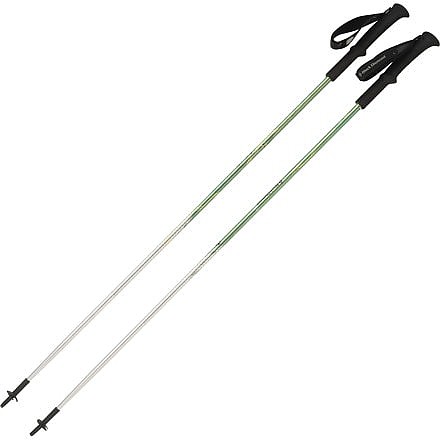
My age betrays me. Before buying these poles I thought of trek poles as an experiment for me. I assumed that I would end up giving them to someone else. Nope, that's not going to happen since I now love them. In fact, I've let four people try these, and exactly four of them have now bought a pair for themselves.
Pros
- Folds up small — very "stow-able"
- Comparatively very lightweight, so the poles are very controllable and do not have the "swing" issue that heavier poles have
- Holds up to use (does not break under normal tensions)
- Z-pole design makes it simple to both deploy and collapse
- Z-pole lock is perfectly secure
- Straps adjust nicely
- Poles do not have the vibration found in some carbon fiber poles
- Accessory tips are easy to install and remove
Cons
- A little heavier than I wanted
- Length is not adjustable
- Baskets are too small for snow, and can not be replaced on this model
- Accessory tips are almost too difficult to swap in the field - they are more of a (quick) shop project
Trekking poles and walking staffs are certainly nothing new. Historically I've regarded them as things that an athletic young fella wouldn't benefit from. Turns out, while I am still making an effort to be athletic, I'm pretty clear that I'm not young any more. Happens to all of us. :)
In the last year or two I've been making many changes to my gear and general approach to hiking / backpacking, so I've been trying to stay open to ideas about all gear. Trekking poles were at the top of the list of items that I didn't think I would need, but that were highly recommended. I've been genuinely surprised and delighted to discover just how useful these poles are.
Not specific to these poles, here are the benefits and observations I have related to trekking poles in general:
- Using poles helps create a speed cadence. I don't know that I'm going any faster, but it feels like I am. I also think that I take less breaks while using trek poles. This helps to keep the adventure moving along, though I've found that I don't drink as much water or as often when using trek poles (after all, the hands are occupied).
- Using poles when climbing steeper grades helps provide the leverage to make ascent much easier than without them.
- Using poles definitely helps reduce the knee pain of descending a mountain. I also feel like descent in tenuous footing is much safer with trek poles. Four days ago I stopped my own fall when my Left boot slipped on loose gravel during a descent. Yea for Trek Poles!!
- I've crossed a few streams with them — in my opinion there is a notable safety advantage to using poles during water crossings.
- Last but not least, using trek poles allows a user to hop over obstacles without slowing down. Hey, who doesn't like to hop?
Now on with the review about these poles.
Model Specification: First of all and to be specific, this review is about the 2012 model. Black Diamond makes a distinction between the 2012 version, and the new version of the Distance Trekking Pole. I have not been able to distinguish the difference (except color), but apparently there is one. In fact, if you know the difference please let me know in the comments as I am admittedly curious.
Length: 120cm
Weight: 12.3 ounces
Color: just lovely
Testing Details: I have had these out on seven trips with an aggregate mileage of about 54.5 miles. I've used these in low altitude forest, sub-alpine forest, bushwhacking and snow conditions. They've been with me in over 14,000 feet of ascent, I've used them in water crossings and they've taken my full weight on at least 15 occasions without bending, breaking or showing any sign of failure. They've also been caught in a crack twice where a weaker pole might have snapped. Instead, they held in there even with me continuing on before noticing they were stuck.
When are they useful, and when do I put them away? This is easier to answer than I might have thought. I fold up the poles into my pack when I'm on a long flat straight-away. I don't feel like I get any benefit from the poles during this part of hiking. If I am ascending, descending, or crossing more than 6" of flowing water... I have these babies in my hands.
Black Diamond's Z-Pole design: I think Black Diamond's stowage design is worth mentioning. Heck, it's the reason I bought them. As my first trek poles, I didn't know if I would even like trek poles or not. I didn't know when I'd want to use them. I didn't know if I would want to stow them in my pack while hiking, or if stowing them would be useful at all for that matter. Because I felt like I wanted the option, I was relegating my choice to either the Z-pole design, or to some kind of telescoping design.
There are some telescoping designs that get short enough to stow in my 34L backpack, but not all. I think in most cases I would end up with poles sticking up over my head when stowed in the side pocket of my pack.
Here's a picture of how I stow my poles while not in use. Imagine the poles being longer and you start to get the idea that with longer poles I'd look like I'm carrying a HAM radio in my pack. Not only is that not a good look, but it would get caught every time I go under a log / tree. No thanks. This works great.
The other notable function of the Z-Pole design is how the pole breaks down and how it extends for use. I think Black Diamond's video does proper justice to how the Z-Pole extension and locking works. Here it is:
Here's a pic with the poles out of the pack:
Here's another pic with the poles fully extended. Full extension requires a full engaged "click" of the locks. I don't know how else to describe it. The video doesn't really show this particular detail either. Once you hold it in your hands, you'll understand immediately. It's very simple.
Durability: One thing I looked for when buying trek poles is that some designs seem to have a tendency to be brittle or to bend. This tends to more be the case if a pole is made from carbon fiber or if the poles are adjustable in length. To be clear, I recognize that I am making a sweeping and broad assertion here and I don't expect one carbon fiber pole to perform like another. I'm simply stating that my research found some patterns with certain materials and designs.
In general I found that aluminum poles are heavier, albeit generally thought of as more reliable. I can't make a "more reliable" statement about these poles, but I think I've put them through some pretty demanding testing and I now do not have any question that the Black Diamond's Z-pole design is a winner for durability.
Choice of Length: Mine are the 120cm poles, and I do think that the length decision is worth noting. Obviously there's a fit issue here. At 5'10" I'm told that 125cm would be perfect. I don't know what makes a fit perfect, but 120cm has been great for me (the next longer choice would have been 130cm).
There is something else to consider regarding pole length, and I think this is at least one reason why some users prefer an adjustable pole. You can use your trek pole in the place of your tent pole. At 120cm mine works fine as tent-pole replacements in both my backpacking tents (one is a Six Moon Designs, the other is TarpTent). They're a little shorter than the manufacturers recommend, but the next size up (130cm) would have been too long. Choices choices.
Grips: These little fellas have EVA foam grips. They can tend to be a little sweaty, but I don't think that will make them any less grippy or stable. As I mention a little later in this review, I briefly tested Black Diamond's Alpine Ergo Cork trek poles. I have to say, I really did like those grips a lot better. But, when I went back to my poles, I still did not feel like I was somehow giving anything up.
Does the Pole Weight matter? Oh man, yes, I think it does. I had an opportunity to trade poles with a buddy on a recent trip for a few miles. He was using the Black Diamond Alpine Ergo Cork trekking pole. Even though they are made from Carbon Fiber, they weighed in at 20 ounces whereas mine are roughly 12 ounces. At 12 ounces mine feel very lightweight and nimble. A different 9 ounce pair of poles that I've looked at feel just as nimble, though I didn't feel like they were functionally different from my 12 ounce trek poles.
At 20 ounces I think the Alpine Ergo Cork is like swinging bricks. YMMV, but I really did not like the weight difference. Because they seemed heavy, I felt like they could not keep up with me as I was moving. As a side note that didn't help my impression of the Alpine Ergo Cork, they suffer from the shake / vibration that is common with Carbon Fiber poles. Mine do not.
Does the pole's material matter? I think yes, though I don't feel like I have enough experience with this to make a perfect call on the subject. That said, and as I just mentioned, I think there are at least some Carbon Fiber poles that have a vibration that is pretty irritating. I do not experience this issue with the aluminum Distance Z-Pole.
I've read a few places that Carbon Fiber also has a tendency to be brittle such that they might fail at just the wrong time (when you need them most). I suspect that different manufacturers have different quality in this respect, so if you're up for Carbon Fiber I'd think a careful review of specific products would be in order. Here again, I have not experienced anything like that with the aluminum Z-poles. Good stuff.
Strap adjustability and utility: The straps are adjustable, and I find that even fully tightened they are a bit loose. But then there's a question about how they should be used. Do you want the poles strapped to you tightly, or do you prefer some movement? I like the ability to move within the strap so I can adjust my grip as needed. Here again, this is a YMMV situation.
How do adjustment and collapsible joints make a difference to durability, utility or field failure? From my limited exposure to the Alpine Ergo Cork model, I think there is a difference worth paying attention to. I'll look to someone else to get better experience with the FlintLock Pro joint that's used on the Alpine Ergo Cork pole, but they do seem very strong to me. Specific to the Z-pole Distance trekking pole (mine), I think the Z-Pole joints are very strong and they don't seem to be susceptible to failure... at least not after 54 miles. :)
Basket Size and Utility: Alas, here is something that is less than perfect about these poles. The basket size is as small as it could be. In the snow, the baskets are useless... use-less. To make things worse, the Z-Pole design does not allow the base to be swapped out. That means you can not easily change or remove the baskets that come with it.
There is a small silver lining here though: if a person wants a larger basket, they can opt to buy one of the three Ultra Mountain versions that Black Diamond offers. But again, even though you can opt to have a larger basket you are then stuck with that decision.
One question about the basket size that I think is relevant is: even though the basket is small on this model, does it matter? YMMV, but I've been happy with it since I recognize that a larger basket would get caught on brush. I guess you just have to make a decision and go with it.
I hope this helped. Happy Adventuring!
Source: bought it new
Price Paid: $50
A simple, lightweight set of folding aluminum trekking poles great for dayhiking, backpacking, and trail running. Highly recommended!
Pros
- Lightweight
- Easy to deploy
- Simple
- Comes with rubber tips
- Not adjustable
Cons
- Wrist strap is short
- Grips leave residue
- No snow baskets available
- Not adjustable
I've been a fan of trekking poles since I started backpacking solo as a teenager. The stability and joint protection they offer are always worth the weight. After years with the same pair of LEKI's, I decided to give Black Diamond a try in preparation for a trip to Mount Whitney. Their 2015 Distance Z's seemed to offer everything I wanted:
- Lightweight
- Simple design
- Great price
Grip and Straps
The grips are a light, soft foam with deep grooves for ventilation and traction. The grips are simply shaped, with a nice positive angle for ergonomics. No deep grooves for each finger, but the grip is still true and never seems slippery. The "mini-grip extension" is just a smooth portion of the foam grip that extends below the upper primary grip section and stands in place of adjustability on continuous uphills: instead of shortening the pole, just slide your hand down and you have a comfortable grip.
The straps are light and breathable mesh and webbing with a hook-and-loop (Velcro) fastener. They are comfortable on long days. The only gripe I have is that the hook-and-loop portion is very short, and when you let out a lot of slack, you almost max out the length of fastener. They feel secure, but I fear after a couple years that the hook-and-loop may wear out. Also, after a long hike with no gloves, the foam grip leaves a black residue. Not a huge deal, but a quick wash of the hands is necessary if you're going from trailhead to the office.
Speed Cones
The blue-coated wires that connect the pole sections are called "speed-cones" apparently. They are quick to deploy and tension across the three sections is held with a spring-loaded pin that protrudes right beneath the foam grip. The pin is small, and can be tricky to push in with gloves on; but, it feels sturdy. You can even adjust the tension of the pole sections. I assume the wires may stretch out over time, so the gray threaded portion of the speed cones (pictured) will be very helpful to keep the pole sections tight and sturdy.
I listed the lack of adjustability as a Pro and a Con: I bought the poles because of the low weight. That weight is achieved through the lack of adjustable cams or threading. It is actually a feature I like because of the resulting simplicity. But, I know some people would find that to be a negative.
Pole Tips
The Distance Z's come with two sets of threaded pole tips: rubberized tips for use on pavement or long stretches of bare rock, and carbide tips for the best grip on rough terrain. They are challenging to get on and off but that's a good thing! I used an old rag with blunt nose pliers to change from the stock rubber to the carbide tip. They are ridged so they don't torque off during use.
The built in "summer" basket is good for purchase on loose dirt and gravel. I used these on a three-day trip through the Mount Whitney High Country, and the carbide tips gripped the sometimes-slick granite on the Whitney Trail. After many training hikes for Whitney and general use, the carbide tips still look great.
One thing I don't love about these poles is that BD does not make a snow basket compatible with the Distance Z's. These poles are not necessarily intended for snow use, but I think for snow trekking or snowshoeing, these would be great if a compatible snow basket existed.
Overall
These poles are great! The weight (13oz for 120cm size) is lighter than my Leki's; the durability has been great; they deploy quickly and reliably; and, the grips are comfortable for long days on the trail. Pick up a pair!
Source: bought via a "pro deal"
Price Paid: $48
Lightweight, foldable trekking poles great for casual hikes, but can go the distance. Highly recommended.
Pros
- Foldable design allows for easy transportation
- Lightweight
- Ease of use
Cons
- Hand grip material and feel
- Basket and tip design
I purchased these Black Diamond Distance Z trekking poles for a specific purpose. I often travel to backpack and I wanted some poles that were compact enough to fit inside my backpack or bag. That meant that they had to fold to less than 20 inches. These poles fit the bill.
The fit of these poles is determined when you buy them. The poles are non-adjustable so you should buy poles that will fit you for hiking on level ground. I typically hold a pole by the grip with the tip on the ground and if my elbow is at a 90 degree angle I feel like it is a good fit.
The grips on these poles are made of foam rubber. There are higher quality grips available. The grips do an adequate job of tactile feel, but I would not say that they are the most comfortable. I own some Leki poles with better grips. The grips have some corners versus rounded edges. Some people might like this, I tend to find the rounded edges more comfortable. I am able to grip the handles from up top or from below—the grips extend below the traditional handle. I do like the lightweight wrist straps.
What these poles give up in terms of adjustability, they make up for with their folding ability. They are extremely compact. They are extremely easy to deploy for use and retract for packing away. The poles lock into shape by simply pulling the top section down until the locking mechanism moves into place. By pulling the top section down the bottom sections easy connect and fall into position. The poles unlock and fold by pressing the buttons and sliding the poles out, then folding.
I've pretty much used only the rubber tips. The poles come with rubber tips and carbon tips. The tips are easily interchangeable by screwing the bottom piece in or out. I added a little loctite to the screw to reduce the chance of the tip unscrewing. The poles offer good traction. They are moderately stiff. The baskets are somewhat small and probably would not be useful in snow. But for casual use in solid ground, mud, and in water they work fine.
I do like the wrist straps. I have not use the carbon tips at all, nor the little strap to hold the poles together. I like to go with the lightest possible setup.
These poles are extremely easy to use and would be great for anyone from beginners to experts. They have proven to me to be reliable and durable for over 600 miles hiking on El Camino de Santiago, Oauchita Trail, Big Bend, and other shorter trips.
I was able to find these on sale for $69 and think that they have been a great value at that price. The normal price is around $99.
Source: bought it new
Price Paid: $69
I broke these in over the course of a weekend car camping trip—so nothing over the top, but I managed to use them over a variety of terrain over the course of about 6-7 miles. This included grass, pavement, volcanic rock, river rock, stream crossing, a wood planked bridge, and good old dirt.
First off, they are very lightweight and fold up to a very compact size. It would be difficult to not find a Place to pack these. They deploy and collapse very simply and the snap lock insures a mechanical stop to keep them deployed. The rubber tips were easily changed to carbide tips by simply screwing them with pliers.
The foam grip provides adequate feel and the mini grip extension was somewhat useful on ascents, although a larger extension would be even better. My only drawback regarding the foam grips, were that they became a bit slick with excessive sweat, but adjusting my grip to allow air flow seemed to dry them out quickly enough.
The straps (which came sized S/M) seemed a bit too short and were not the most comfortable. However, they were not so uncomfortable that I had to unstrap them, I just rather ended up getting used to them. Even at their largest adjustment, I found them too small to adequately adjust my grip when quickly moving from flat terrain to an ascent or descent.
I did not encounter any soft terrain, so I was not able to evaluate the size of the cups. Although, their small size allowed me to fit the poles in small crevasses between loose river boulders which provided me the stability needed at the time.
All in all, I am satisfied and would recommend them, especially if you are looking for a shorter pair of poles (100 cm).
Price Paid: $79
Compact and strong, these poles are great to take anywhere. However make sure they're the right size.
Pros
- Compact
- Durable
Cons
- Non-adjustable
- Sometimes snag apart
I love this product because of how incredibly compact it is. I don't need or use poles often, but I like to carry them in case I do. These ones even fit into my smallest daypack! They collapse and open in seconds, and are not a bother when I suddenly decide to use them mid trail.
They aren't adjustable, but I think that keeps them from slipping. Adjustable ones I've encountered start sliding as they get older which I find frustrating. These ones though will pull apart a bit if they are throughly snagged. The pieces stay connected, and I can generally shove it back together without stopping, so I don't see it to be much of a problem.
The baskets are small and I prefer them that way. Haven't tried to change them yet. The tip hasn't slipped enough to need anything bigger, so it hasn't been a concern.
I've had them only a year and they haven't broken yet, though I was afraid they'd dent easily originally. They have mostly been used in Hawai'i on trips that were about 7 hours a day. The weather has ranged from pouring and wet to dry and rocky.
Source: bought it new
Price Paid: $69.93
These trekking poles are awesome! Perfect for those ounce counters!
The foam handles are very comfortable and you can still grip them when your hands are sweating. The straps are very comfortable and well designed.
They are so convenient because they fold up so small. They fit in your pack easily and are the perfect size for taking on a plane. They are extremely stable for their weight.
My only complaint is that there are no snow baskets and no way to attach snowbaskets.
Price Paid: $83
Collapsible, sturdy trekking poles.
Pros
- Collapsible
- Sturdy
- Comfortable
Have owned for about four years. Have always opted to backpack with poles, mainly because I like the support. Also double as setup for my tent if I don't have the option to sink pins.
I like the way they fold up for pack-ability. Seem fairly lightweight, though I haven't used any others for comparison. Hand grips are comfortable, no issues after a long day.
The length is slightly adjustable depending on your height. The locking features are also strong, yet to slip or give out in my usage.
Please with them. At this point, there are probably lighter options, but unless they break, I plan to use them forever.
Source: bought it new
Price Paid: $50
Got these at last year's summer REI Garage sale and they were never used. They have changed my hikes completely!
Pros
- Light
- Compact
- Sturdy
Cons
- No adjustable baskets (ie no snow baskets)
- Non-adjustable length
Love these poles. They have extended my downhills and are completely worth the negligible wieght!
Source: bought it used
Price Paid: $50
Your Review
Where to Buy
You May Like
Specs
| Price |
MSRP: $99.95 Current Retail: $132.95-$139.95 Historic Range: $0.01-$139.95 Reviewers Paid: $48.00-$83.00 |
| Weight |
11.2 to 13 ounces per pair (depending on length) |
| Lengths |
100, 110, 120, 130 cm |


